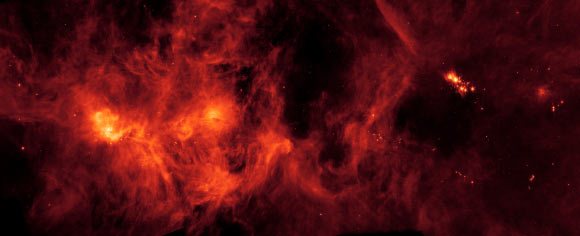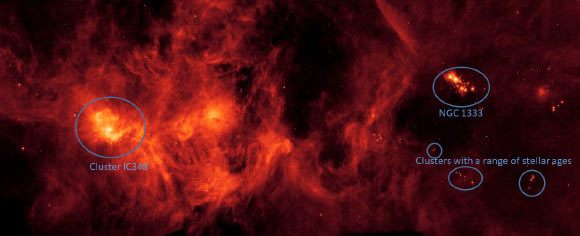Spitzer Observes Perseus Molecular Cloud | Astronomy – Sci-News.com
NASA has released a stunning image of the Perseus molecular cloud, a giant stellar nursery about 600 light-years away in the northern constellation of Perseus, captured by the agency’s Spitzer Space Telescope.

This image, taken by Spitzer’s Multiband Imaging Photometer (MIPS) instrument, shows the Perseus molecular cloud. Image credit: NASA / JPL-Caltech.
Infrared radiation from warm dust generates much of the glow seen here from the Perseus molecular cloud.
Clusters of stars, such as the bright spot near the left side of the image, generate even more infrared light and illuminate the surrounding clouds like the Sun lighting up a cloudy sky at sunset.
Much of the dust seen here emits little to no visible light and is therefore revealed most clearly with infrared observatories like Spitzer.
On the right side of the image is NGC 1333, a reflection nebula located about 1,000 light-years from Earth.
NGC 1333’s proximity and strong infrared emissions made it visible to astronomers using some of the earliest infrared instruments.
Many young stars in the object are sending massive outflows of material into space.
As the material is ejected, it is heated up and smashes into the surrounding interstellar medium.
These factors cause the jets to radiate brightly, and they can be seen in close-up studies of NGC 1333.

An annotated version of the Spitzer image of the Perseus molecular cloud. Image credit: NASA / JPL-Caltech.
Other clusters of stars seen below NGC 1333 in this image have posed a fascinating mystery for astronomers: they appear to contain stellar infants, adolescents and adults.
Such a closely packed mixture of ages is extremely odd. Although many stellar siblings may form together in tight clusters, stars are always moving, and as they grow older they tend to move farther and farther apart.
Finding such a closely packed mixture of apparent ages doesn’t fit with current ideas about how stars evolve.
“This region is telling astronomers that there’s something we don’t understand about star formation,” said Dr. Luisa Rebull, an astrophysicist with NASA’s Infrared Science Archive at Caltech-IPAC.
“The puzzle presented by this region is one thing that keeps astronomers coming back to it. It’s one of my favorite regions to study.”
_____
This article is based on text provided by the National Aeronautics and Space Administration.





